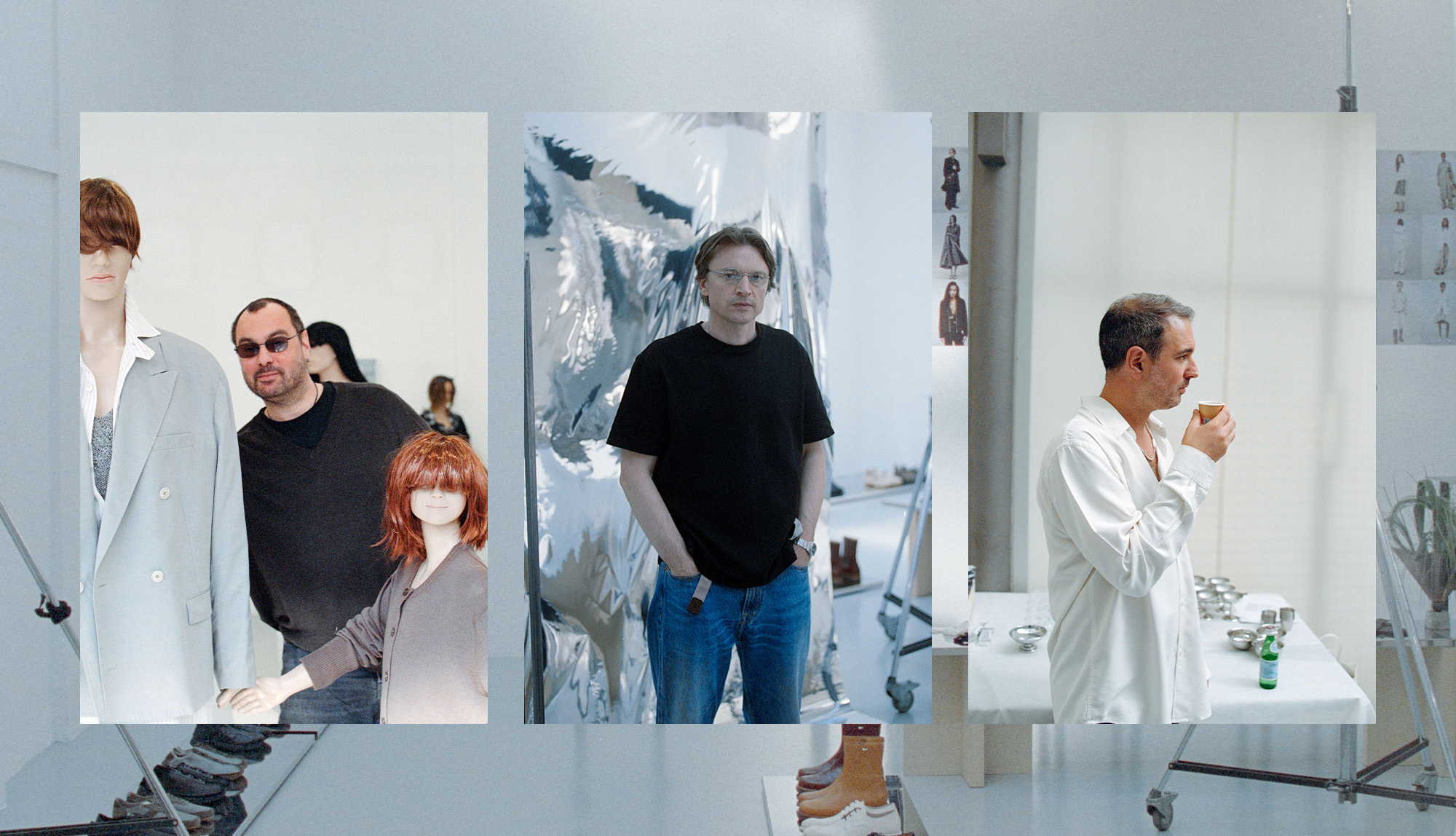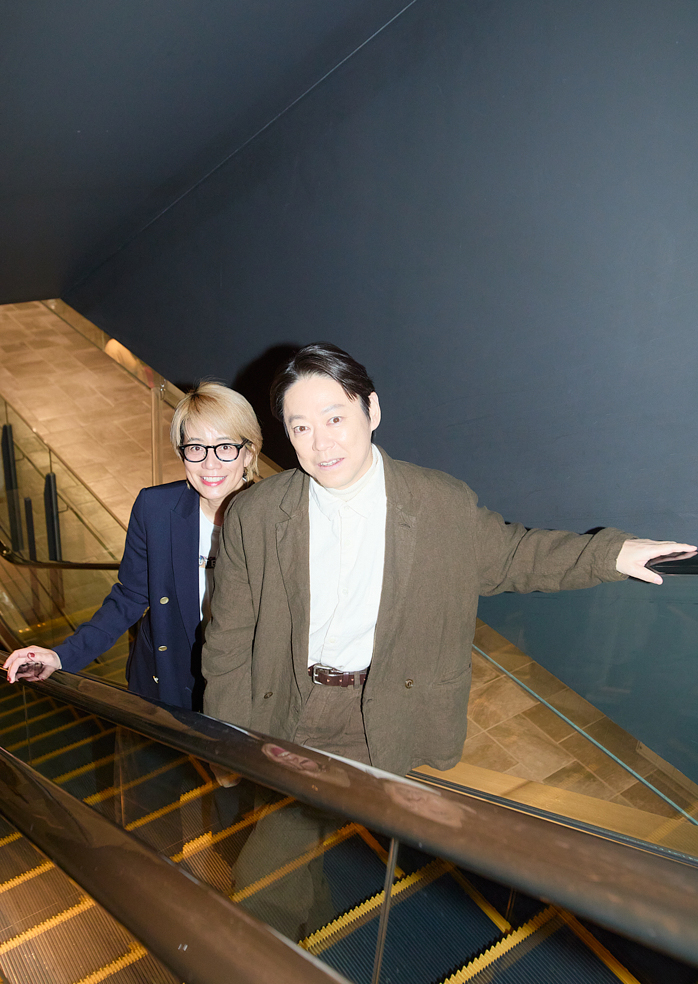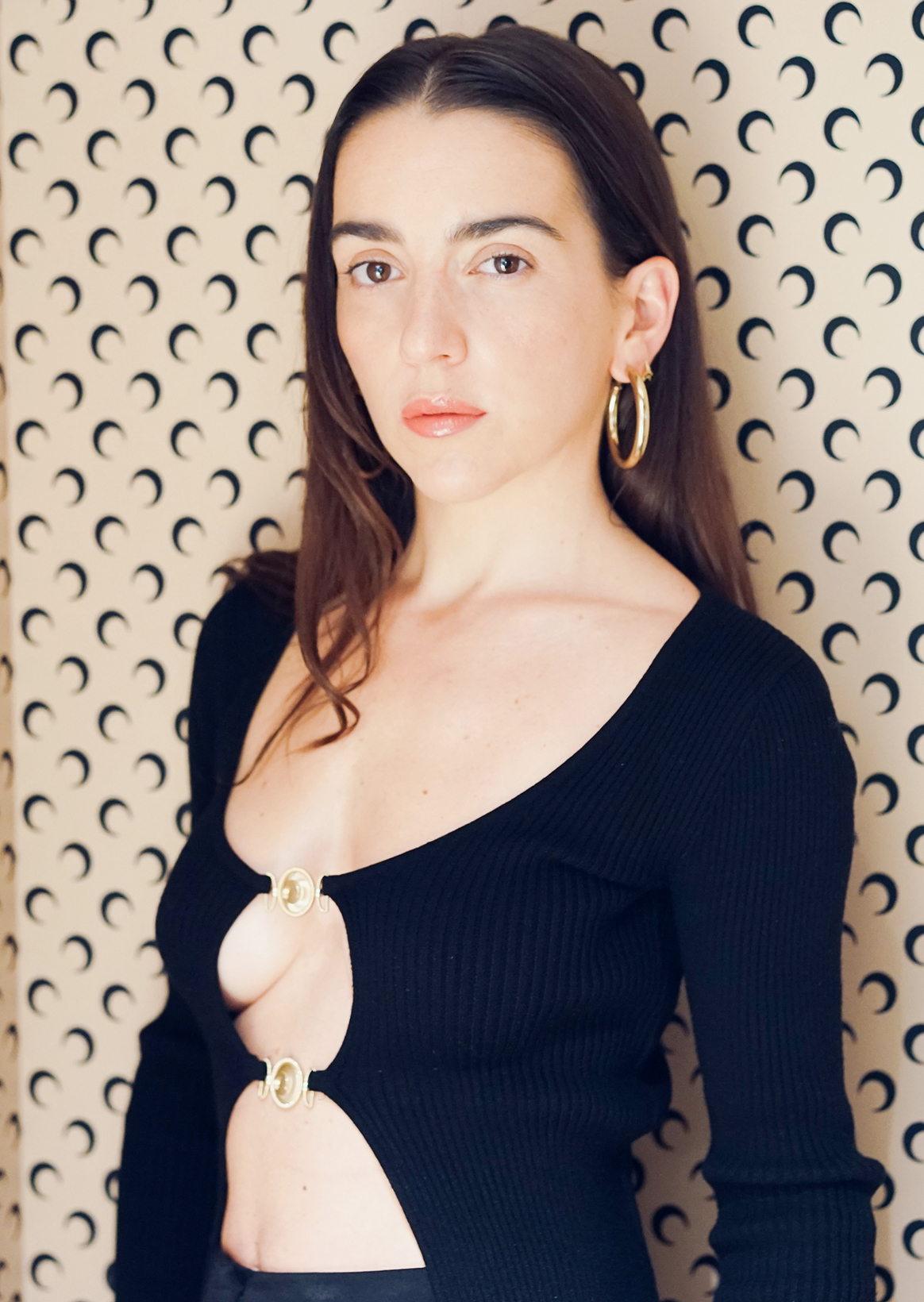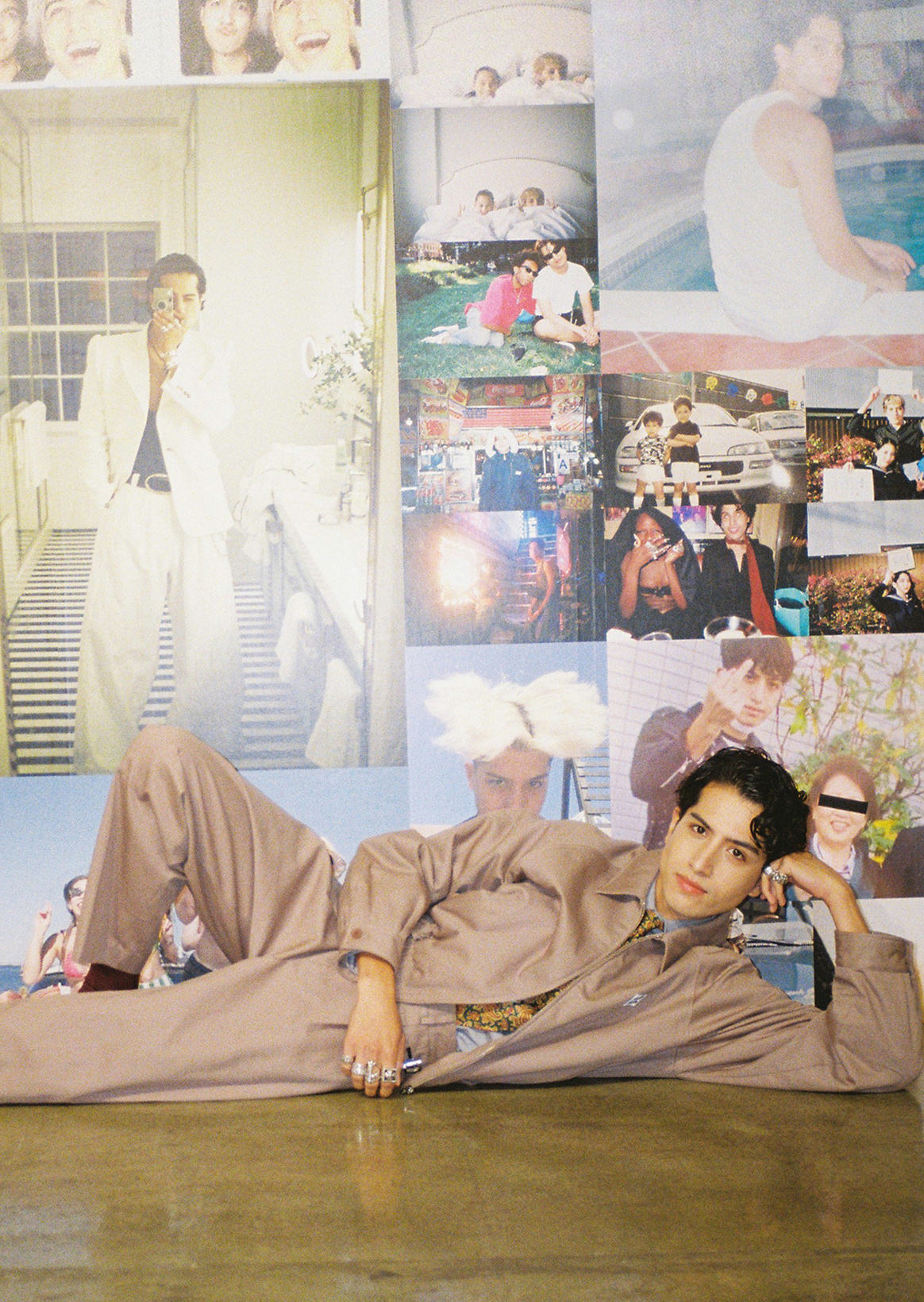10代でアイスホッケーを通じて出会い、友人となったヨックム・ハリンとクリストファー・ニーイングが、2005年にストックホルムで「OUR LEGACY」を設立し、やがてリカルドス・クラレンが共同経営者として加わった。20年近くにわたり、音楽、スケートボード、アートブックといったストリート・カルチャーから影響を受けて育まれた感性は、既存のファッションという枠組みを超え、持続可能性を探求する表現を生み出し続けている。2025年6月13日、渋谷 PARCO 2Fにて日本初店舗となるショップインショップをグランドオープンした。2016年から続く、サステナビリティを意識し、デッドストックやサンプル、リサイクル素材を再利用したプロジェクトWORK SHOPのアイテムも展開している。服を通じた表現、創造の原点、そして東京から受け取ったインスピレーション――。今回のメールインタビューでは、彼らの歩みと創造に対する哲学を紐解く。
※ The English version is available below.
- Photo
- Nils Junji Edström
- Text
- Tomoko Ogawa
- Edit
- RIDE Inc.
 Jockum Hallin
Jockum Hallin  Christopher Nying
Christopher Nying  Richardos Klarén
Richardos Klarén
ーーヨックム・ハリンさんとクリストファー・ニインさんは10代の頃、アイスホッケーを通じて出会ったとき、お互いにどんな印象を持ちましたか? 当時どんな10代を過ごし、今も自分たちの中に残っていると感じる部分があれば教えてください。
ヨックム・ハリン(以下、ヨックム) クリストファーと出会ったのは13歳のとき。ジュニアのアイスホッケーの練習で、あまりに上手だった彼は、年上の僕のチームに昇格してきたんです。僕は1980年生まれ、彼は1981年生まれなので歳は近いですが、その頃の僕はすでに音楽やスノーボード、スケートボードといった自分を形作るものに夢中で、ホッケーから離れつつありました。僕自身はホッケーを始めるのが遅くて、居場所をつかむために必死に努力していたんですよね。一方クリストファーは、エネルギーに満ちた新星としてチームにやってきた。その姿勢は今も同じです。彼に会う人は、その粘り強さやエネルギー、好奇心に驚かされるはず。彼は常に突き進む人で、それは昔から変わらないです。
クリストファー・ニイン (以下、クリストファー) 一緒にホッケーをやっていたのですが、初めて会ったのはバスの中でした。ヨックムは落ち着いていて、格好良くて、音楽に夢中なスタイリッシュな人、というのが最初の印象でした。その印象はずっと変わりません。
ーー初めて、創造することの喜びを感じたのは、どんな瞬間でしたか?
クリストファー 最初は油絵を描いたり、彫刻を作ったりしていました。洋服に関しては16歳のとき、地元フースクヴァーナで友達と一緒にジーンズを実験したのが始まりです。車の後ろにロープでジーンズを結びつけて、泥の上を引きずってダメージをつけました。その後、ジーンズをはいたままシャワーを浴びて、サウナに入って乾かしました。そのときのワクワク感は今でも鮮明に覚えています。
ーー服を通じて、自分を他者に説明し、表現することの大切さについて、どのように考えていますか?
ヨックム 若い頃は、自分のアイデンティティや居場所を探すために服が大きな役割を持つものです。服は説明不要で自分を表すことができる。それによって人が寄ってきたり離れたりして、仲間や友人を見つけるきっかけになる。大人になってからも、服は自己表現の手段であり続けます。きちんとした人に見せたいのか、自由でクリエイティブに見せたいのか。服は強力なツールであることに変わりはないですが、歳を重ねるごとにその関わり方は少しずつ変化していきます。
ーー自分たちが本当にやりたいことを実現し続けるために、必要なことは何だと思いますか? また、そうできる自分になるために、あなたを鍛えてくれた経験とは?
クリストファー 僕にとっては、グラフィックデザインが大きな入り口でした。フィジカルな制作とデジタルな制作を行き来することを学べて、そのバランス感覚はイメージをかたちにするための手段になりました。これは今でも服作りや感情を視覚的に表現するときにも役立っています。そして、常に刺激をくれるのが本です。特にアートブックや写真集は、昔からずっと僕をワクワクさせ続けてくれる存在です。
ーーちなみに自分を育ててくれたアート作品とは? そのとき、どんな感覚が呼び起こされましたか?
クリストファー マルセル・デュシャンの作品の捉え方に大きな影響を受けました。彼は作品をすごくコンセプチュアルに扱っていて、その自由さが印象的です。ニューヨークで発表した作品をストックホルムのキュレーターがコピーしたときも、彼は怒るどころか「いいじゃないか」と肯定した。誰でも自分の作品を複製できるという考え方は、物議を醸しつつもとてもオープンマインドですよね。代表作の「R. Mutt」と署名した便器は有名で笑えますが、彼自身のお気に入りは展示で誰にも気づかれなかった櫛だったという話も好きです。そういう境界のなさに強く影響を受けました。今でも創作に対する自由な姿勢を思い出させてくれます。



ーーOUR LEGACYはファッションではない異なるバックグラウンドを持つメンバーでスタートした強みを持っているからこそ、ファッション業界の中で、プラグマティックでありながらユニークで、プログレッシブかつサステナビリティを実験できる場を築けているのだと思います。そうした場を成立させ続ける秘訣とは?
ヨックム まさにその通りだと思います。会社が大きくなるとヒエラルキーや意思決定の仕組みは必要ですが、僕らは同時にオープンで民主的な働き方を大事にしています。誰が考えたかではなく、常に「一番良いアイデアが勝つ」という姿勢を持ち続けているんです。雰囲気としてはすごくリラックスしていて、ファミリー的な職場です。お互いを助け合いながら楽しく働く。ファッションは楽しいものですから。服や食べ物、ワイン、スポーツ、アート、写真、音楽……そういうものに囲まれて働けるのは本当に幸せだし、その楽しさは会社の雰囲気や仲間意識に表れています。
ーークリエーションにおいて、インスピレーションの源になっているものは?
クリストファー たいていは、葛藤から生まれます。何かに行き詰まって、でもふとした瞬間にアイデアが浮かぶ。シャワーを浴びているときや料理をしているときに突然、カチッとハマる感じです。その瞬間を逃さないようにしないといけない。あとはやっぱりアートブックや写真集。昔から同じ本を何度も読み返していますが、そのたびに新しい発見があるんです。探しているわけじゃなく、自然に出てくるもの。僕にとって、創造性は無理やり生み出すものではないと思っています。
ーーOUR LEGACYにおける重要な取り組みのひとつである、WORK SHOPを始めてから、どのような学びがありましたか? 約10年間の「なるべくゴミを出さずに服を作る」という哲学を進める過程で直面した課題や、新たな発見についてもお聞かせください。
ヨックム WORK SHOPは僕たちにとって大切な存在で、OUR LEGACYのエコシステムに欠かせないものになっています。メインラインとWORK SHOPは相互に作用していて、どちらか一方では成り立ちません。大きな課題は、大企業との取り組みです。僕らは小さくて身軽に動けるけど、大きな会社はどうしても動きが遅い。タンカーを方向転換するようなものですね。でも僕らは根気強く取り組んでいて、その姿勢がパートナー企業にポジティブな影響を与えることも多い。既存の素材を活かすこと、新しい持続可能な解決策を見つけることは難しいですが、その分大きなやりがいがあります。

ーーシルエットやテクスチャー、服の中に過去の記憶が宿る一方で、OUR LEGACYは“再解釈”によって新しい文脈を生み出しているように見えます。ノスタルジアと非ノスタルジアのバランスについてどう考えていますか?
クリストファー 僕自身はあまりノスタルジックだとは思っていません。多分それは服を着る人や見る人が感じるものでしょう。僕にとっては、本当に好きなものを集めて持ち続ける感覚の方が近くて。たとえば2026年春夏コレクションでは、初めて買ったヴィンテージのアイテムを元にしたジャケットを作りました。それはまだファッションに携わる前で、ただ、好きだからという理由だけで手に入れたミリタリーのつなぎ服でした。上半分だけを残して切りました。特別に懐古的な意味はなかったけど、人によってはノスタルジーを感じるかもしれないし、新しい世代は全く違う捉え方をするかもしれない。僕にとっては、いま誠実に再解釈することであって、過去を再現することではありません。
ーークリエイティブ・ディレクター、デザイナー、CEOといった役割分担がありつつも、どうやってうまく3人でバランスを取りながら協働作業をされているのでしょう?
ヨックム 20年以上一緒にやっていますが、役割がはっきりしているのが大きいと思います。それぞれが独立性を持ちながら、自分の領域で自由に動ける。だからこそ踏み込みすぎず、うまくバランスが取れているんです。でも同時に、交わるポイントもあって、一緒にチームとして同じ方向に進める瞬間もある。さらに僕らが3人であること自体が強みです。2人だけだと意見が割れて停滞することがあるけれど、3人いれば必ず決断ができる。時には間違うこともありますが、とにかく前に進めるので。
リカルドス・クラレン(以下、リカルドス) 20年一緒に働いてきたこと、そしてその前から知り合いだったこともあって、とてもやりやすいんですよね。根本的に、僕らは友人同士で、同じような価値観を持ち、ブランドをどう築きたいか、日々どう働きたいかという共通のビジョンを持っている。美意識は時に違うこともありますが、それも良い刺激になっています。さらに、会社全体のチームワークもとても自然で心地よいものなんです。みんなが同じ方向を向き協力し合っていて、それが僕らの強さになっていると思います。


ーー 多くのプロジェクトでコラボレーションを行っていますが、パートナーに求めるものとは何ですか?
ヨックム 僕らが求めるのは、ワクワクさせてくれる存在です。自分たちの鏡写しのような相手ではなく、新しい視点を与えてくれる人やもの。スポーツブランドでもシェフでもワインの生産者でも、ミュージシャンでも家具会社でもいい。自分たちが直接関わっていない分野でも、情熱を感じられるものからは強くインスピレーションを受けています。
ーーストックホルムという文脈を背景にしながらも、グローバルに評価されるブランドとなりましたが、「ローカル」であることの重要性についてはどのように考えていますか?
クリストファー スウェーデンは、ファッションの国ではありません。産業規模も大きくないので、逆に自分たちの世界に集中できます。東京ではファッションの存在感がすごく大きいけれど、スウェーデンでは静かで、自分たちのやり方を持ち込めるんです。個人的には、スウェーデン的であるとはあまり感じていません。僕はストックホルムではなくフースクヴァーナ出身で、自分を形作ったのはむしろ旅でした。だから「ローカル」というのは、出身地でありつつ、それをどう持ち歩くか、という視点だと思います。
ーータクシーカルチャーから着想を得たハンドメイドのユニークピースのように、とりわけ東京・渋谷という街から受けているインスピレーションがあれば、ぜひ教えてください。また、個人的な思い出や印象があれば聞きたいです。
ヨックム ハンドメイドの作品は、フィンランドの家具ブランドArtekとスウェーデンのかぎ針編み作家とのコラボで、東京のタクシーで見られるレースのシートカバーに着想を得たものでした。もし幸運なら出会えるあの美しいカバーですね。東京、とくに渋谷は行くたびに新しい発見がある街です。表面だけでも十分楽しいけれど、何度も行くうちに少しずつ層を剥がすように奥行きを感じられる。その探求して見つける感覚が、東京ならではの魅力だと思います。具体的な思い出というよりも、小さな発見の積み重ねですね。誰かから「この古着屋がいい」「この寿司屋が最高」「この展示を見てみて」と言われて行ってみると、地図の上では迷子になっていて、建物の10階だったり地下だったり、普通のマンションの一室の奥や、洗濯室の裏だったり。膝をついて小さなドアをくぐったら、魔法みたいな空間が広がっていたりする。そんな体験ができる街は他になくて、だから僕は東京に行くたびに同じようなワクワクを感じます。
クリストファー 渋谷の面白さは、混ざり合いにあると思います。職人技もあれば、テクノロジーや未来もあって、5つの街が1つのブロックに詰め込まれたような感じ。そこで迷い込むのが楽しいです。2回目の東京旅行で「のんべえ横丁」に行ったとき、70歳くらいの日本人の男性に声をかけられて、夜を一緒に過ごしました。ご飯に連れて行ってくれて、バーをはしごして、最後はホテルまで送ってくれた。完全な初対面なのに、ものすごく親切でフレンドリーで、その体験は今でも忘れられません。
リカルドス 渋谷は大好きです。ファッション、カルチャー、アート、音楽、何に興味があっても楽しめることがたくさんある場所ですよね。もちろんPARCOを訪れるのも好きですが、キャットストリート周辺でのヴィンテージショッピングも楽しみのひとつです。昔は線路下の横丁で食事をするのが好きでしたが、最近は観光客が増えてしまったみたいですね(笑)。朝は代々木公園でランニングをして、美しい景色を楽しみます。そのあと富ヶ谷を散歩して、美味しいコーヒーを探すのもいい。そして夜はカラオケで締めくくる。ビルの上階なら、どこでも最高の夜になりますよ!

Jockum Hallin and Christopher Nying first met as teenagers through ice hockey, a friendship that later led them to establish OUR LEGACY in Stockholm in 2005. Richardos Klarén joined as co-founder, and together they have cultivated a sensibility shaped by nearly two decades of immersion in street culture —through music, skateboarding and art publishing. Their work has steadily moved beyond the usual boundaries of fashion, pursuing sustainability while creating a distinctive form of expression. On 13 June 2025, they opened their first space in Japan—a shop-in-shop on the second floor of Shibuya PARCO. Alongside their mainline collections, the store also features WORK SHOP, the ongoing project they began in 2016 that reuses deadstock, samples and recycled materials. Clothes as a form of expression, the origins of creativity, and the inspiration they have found in Tokyo—these are the themes we explore in this email interview.
――This question is for Jockum and Christopher. When you first met as teenagers through ice hockey, what impressions did you have of each other? What kind of kids were you back then―and what parts of that still remain in you today?
Jockum: I met Christopher during junior ice hockey training when we were about 13. He was so good that he had to move up and play with an older team - my team. I was born in 1980, and he was born in 1981, so we weren’t that far apart, but I was just getting into things that really shaped me: music, snowboarding, skateboarding. I was on my way out of hockey, while he was just coming in. I started playing hockey quite late, so I had to fight to earn my place. Christopher, on the other hand, came in as this young star full of energy on the ice, and I feel that’s still with him today. I think people that meet him are impressed with his persistence, energy and curiosity. He just keeps on going - always pushing—and that’s something that’s really stayed with him.
Christopher: We played hockey together, and the first time I actually met him was on a bus. Jockum was this calm, good-looking guy with a cool style who was always into music. That first impression of him has really stayed with me.
――Could you tell us about your first memory of experiencing the joy of creation?
Christopher: I started out painting with oils and making sculptures. With clothing, I was sixteen and me and my friend took a pair of jeans to a parking lot in Huskvarna, where I grew up. We tied a rope to the car and dragged our jeans in the clay and then we went home and showered in them and then we sat in the sauna for them to dry. That moment was the first memory of experimenting and I remember the excitement me and my friend had from that experience.
――What are your thoughts on the importance of explaining and expressing who you are to the others through clothing?
Jockum: As you go from young person to teenager to young adult into adulthood, I think clothing has different ways of being important in your life. When you are young, it’s often about identity and finding your place. For me it’s such a direct and effective way to show who you are, without any explanation. Your surrounding can easily gravitate towards or from you which in turn helps you find your group, your band mates, your friends. As you get older, clothing still allows you to express yourself - whether you want to come across as sharp and reliable or more free and creative. It remains a powerful tool, even if your relationship to it changes over time.
――What do you think is essential to keep doing what you truly want to do? And what experiences have shaped or strengthened you to be able to do that?
Christopher: For me, graphic design was an important entry point. It taught me how to move between physical creation and digital creation. That balance became a tool for me to visualize things—something I still use everyday, whether it’s making clothes or visualizing a feeling. But something that always kept me excited and kept me doing what I do is books; art and photobooks always keep me inspired.
―― Is there a work of art that shaped you in a lasting way? What kind of feeling did it awaken in you?
Christopher: Maybe Marcel Duchamp and the way he viewed his own work. I’ve always loved how he approached art conceptually. There’s this story about an artwork he created in New York—if I remember correctly, a curator from Stockholm, possibly Pontus Hultén (though I might be wrong), ended up copying it. But instead of being upset, Duchamp actually encouraged it. His idea was that anyone could replicate his work—you just needed to confirm and sign it, and then it was yours. It’s a controversial concept, but also incredibly open-minded. One of the most iconic examples is the urinal he signed “R. Mutt,” which is just hilarious. And his personal favorite piece? A pet comb that no one even noticed during the exhibition. That became his favorite simply because it went unseen. I think what really stuck with me is that sense of freedom and openness—that there are no real boundaries in creativity. It’s a mindset that continues to inspire me.
―― I think that the unique strength of OUR LEGACY comes from having team members with diverse backgrounds outside of the typical fashion industry. Perhaps it’s this perspective that allows you to create a space within the fashion industry that is pragmatic, unique, progressive, and open to experimenting with sustainability. What do you think is the key to maintaining such a space?
Jockum: This is a very good and very on-point question, it really identifies elements that define Our Legacy and make it such a special place to work at. In a growing company, there has to be some hierarchy and someone who can make decisions, but at the same time, we believe in a more open and democratic way of working. We try to push that mindset every day: that the best idea should always win. It’s not about who comes up with it—it’s about the strength of the idea itself. We have a relaxed, family-style way of working. We look out for each other and help each other out. It’s also a fun place to be. Fashion is fun—and whether your passion is clothing, food, wine, sports, art, photography, or music, we’re lucky to be surrounded by it every day. That joy really comes through in the atmosphere and camaraderie within the company.
―― What inspires your creative process?
Christopher: Often it comes through struggle. You wrestle with something, and then suddenly it clicks—maybe when you’re in the shower or cooking food. You have to be quick when those thoughts come because those ideas are tough to loose. Art books and photo books have also been a big inspiration for me. I still read the same ones over and over, and every time I find new things or new angles. I’m not searching for it—it just happens, for me creativity shouldn’t be forced.
―― Since launching WORK SHOP, what have you learned along the way? How has your philosophy around minimizing waste evolved over the past almost decade, and what challenges or discoveries have shaped that journey?
Jockum: We’ve picked up and learned a lot along the way. WORK SHOP is something we’re really proud of—it’s become an essential part of OUR LEGACY’s ecosystem. The mainline and WORK SHOP exist in a kind of creative symbiosis; one really can’t thrive without the other. One ongoing challenge is working with large companies. We’ve been lucky to collaborate with some of the most respected and exciting brands in the world. Compared to them, we’re small, fast, and tactile - while bigger companies move slower. “Turning a tanker” takes time. But we’re persistent and hold firm in our approach, especially with WORK SHOP, which is more sustainability-focused. That mindset often pushes our partners to adapt in positive ways. Working with existing materials or finding new sustainable solutions is always challenging- but it comes with great rewards.
―― Your work often evokes a sense of nostalgia―through silhouettes, textures, or references―but never feels retro or sentimental. How do you think about the balance between nostalgia and non-nostalgia in design?
Christopher: I don’t really think of myself as nostalgic. I think that feeling probably comes more from the viewer or the person wearing the piece. For me, it’s more about collecting and holding on to things I genuinely love. For example, in SS26 we made a jacket based on the first vintage piece I ever bought—way before I was even working in fashion—just because I liked it so much. It was a military boiler suit that I cut, leaving just the upper part. There wasn’t any grand nostalgic intention behind it. Maybe someone else sees nostalgia in that—and that’s fine. Maybe a new generation sees it completely differently. It’s more about reinterpreting things in a way that feels honest now, rather than trying to recreate the past.
―― Even with defined roles―creative director, designer, and CEO of OUR LEGACY―what keeps your collaboration fluid and well-balanced? What makes this trio work so well?
Jockum: It’s true, it works well. Even though we’ve been working closely together for over 20 years, our roles have always been clearly defined, and I think that’s a big part of why it works. It makes us feel independent and it gives us the freedom to work in our own field without stepping on each others toes. That said, we also have these natural intersections where we come together and feel that we are a team, where we push each other and strive toward the same direction and goal. And the fact that we’re three people is actually a strength. It means we always reach a decision. If it were just two of us, we might get stuck in disagreement and risk not moving forward at all. But with three, two will always agree, and the third has to fold. Of course, sometimes we make the wrong call, but at least we make a call and keep things moving.
Richardos: I think the fact that we have worked together for 20 years and also knew each other before that makes it easier. We are friends at heart, have a lot of the same core values and a common view on how we want to build the brand and work day to day. We also have a lot of the same references even though our aesthetics can differ sometimes, which is also good. Also I want to say that everyone in the company are working together in a really nice and natural way.
―― You frequently work through collaborations. What do you look for in a partner? And is there another word you'd use―something that better reflects your own approach to working together?
Jockum: What we look for in a partner is someone or something that excites us - something that sparks our curiosity and makes us want to learn more. We’re not looking to mirror ourselves, instead we’re looking for partners that can challenge us and that can offer new perspectives. It could be a sports brand, a chef, a wine producer, a musician, or a furniture company - fields that we may not work with directly but that we are passionate about and inspired by.
―― While rooted in Stockholm, OUR LEGACY has gained global recognition. What does being “local” mean to you, and why does it matter?
Christopher: What I like about Sweden is that it’s not really a fashion country. There isn’t a huge industry here, and that gives a certain focus. In Tokyo, the scene is so big—you feel it everywhere. In Sweden it’s quieter, and we bring our own world into it. Personally, I don’t feel very “Swedish” in that sense. I grew up in Huskvarna, not Stockholm, and a lot of what shaped me came from traveling. So being local for me is about perspective—it’s where you come from, but also how you carry it with you.
―― Like the handmade unique pieces inspired by taxi culture, is there anything in particular about the city of Shibuya in Tokyo that has inspired you? We’d love to hear any personal memories or impressions of the city.
Jockum: The handmade pieces were part of a collaboration we did with Artek, a Finnish furniture company, and a Swedish crochet artist. We dressed their chairs with these beautiful crocheted covers inspired by the ones you see in Tokyo taxis (if you are lucky). Tokyo, and especially Shibuya, is such an amazing place. You go there and you’re never bored, there’s just so much to explore. As you go there again and again you’re slowly peeling the layers of the city and discovering all these subtle nuances that make the city so endlessly fascinating. I don’t have one specific memory, but what always stands out is that feeling of being given an address, someone tells you to check out this vintage shop, an incredible little sushi place, or a small exhibition and then you’re standing on the street, completely lost, with no idea where it actually is. You have to stay curious and figure it out on your own. It might be ten floors up in a nondescript building, hidden underground, or tucked away behind a laundry room in a regular apartment block or you almost have to crawl on your knees through a tiny door, only to find the most magical places. That kind of discovery feels unique to Tokyo, and it’s a big part of why I keep coming back with the same excitement every time.
Christopher: What I like about Shibuya is the mix—you have this really strong sense of craft, but also technology and the future everywhere. It can feel like five cities packed into one block, and you can just disappear there. On my second trip to Tokyo, I went to‘Drunkard's Alley and met this older Japanese man, maybe around seventy. He waved at me, and we ended up spending the whole night together. He took me out for dinner, we went to a few bars together, and then walked me back to my hotel, a complete stranger but so friendly and kind to me. It was really random, but one of my best memories from the city.
Richardos: I love Shibuya, there are so many different things to do if you are into fashion, culture, art and music. Besides visiting Parco, I like to go vintage shoping around cat street. I used to like to explore the atmospheric food alleys under the railway tracks but someone recently said that there are too many tourists there nowadays. I usually go running in Yoyogi park in the mornings, beautiful settings. Also walk around in Tomigaya and look for the perfect coffee. End the night with Karaoke somewhere, anywhere high up in a building will do!

- ショップ名
- OUR LEGACY
- フロア
- 2F
- 公式ブランドサイト
- https://www.ourlegacy.com
- 公式SNS
- Instagram(@ourlegacy)




